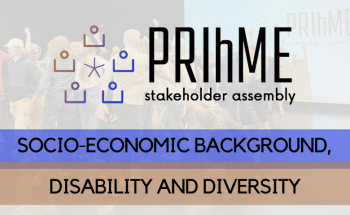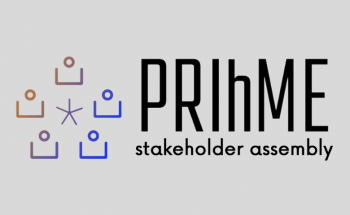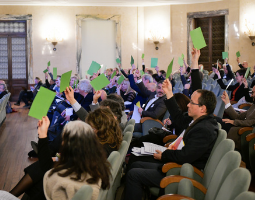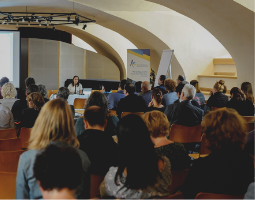Power Relations Toolkit
This tool kit is an important starting point for all who work, study, engage in research, or hold positions of authority in Higher Music Education Institutions (HMEI). The suggested roadmap is meant to be as comprehensive as possible, and has been drawn from meetings within participating institutions.
How diverse is your academic community?
Are there issues that are not being addressed?
Have you perceived power imbalances, or a need for greater transparency?
How many times have you wanted to change something without knowing where to start?
How can you help your own institution grow and change?
How can you help institutions that are facing more challenging journeys?
Feel free to add your own ideas for improving power relations in higher music education. We have taken a comprehensive approach, so some suggestions may be more or less relevant, depending on your current situation.
A PRIhME Participant: “We are students now – this project is designed to help us be better professors in the future”.
| IDENTIFY POWER RELATIONS IN YOUR HMEI | THINK! PREPARE A SOLID ACTION PLAN! | PROVIDE CARE AND SUPPORT | CREATE SAFE(R) SPACES |
| LEARN ABOUT TOOLS AND HOW TO USE THEM | DETERMINE YOUR LANGUAGE OF COMMUNICATION | COMMUNICATE! | CONNECT TO OTHER HMEIs/ ORGANISATIONS |
| GET HELP | LEARN AND SHARE KNOWLEDGE | ESTABLISH A SYSTEM OF CLEAR POLICIES & PROCEDURES | IS THERE MORE I CAN DO? |
IDENTIFY POWER RELATIONS IN YOUR HMEI
- Think about power
-
- What types of power exist in your institution, and how are they used, be it in good or bad ways?
- How might you use power to empower?
- Distinguish the different types of relationships, structures, and hierarchies
- Observe what is changing
- Identify the nature of student-teacher relationships. In some instances, these may be very formal, whereas, in others, students enjoy a more informal relationship with their teachers. Students may be afraid to speak out, given the important role professors often play in their future professional networks, or in their potential professional success. Establishing a clear code of conduct can help avoid situations in which students may feel uncomfortable or excluded. The academic community needs to be aware of and sensitive to the complexity of professional relationships, as these can have a great impact on the teaching and learning environment.
- Are student-teacher relationships transparent? Is there a balance?
- Who has the power to do what? How is the ladder of hierarchy constructed? Who has bottom-up power? What power is hidden, and what is taboo?
- Do students feel safe speaking out, or are they afraid to do so?
- Are teachers’ relationship to their students more formal, or are they more informal?
- Is there a formal code of conduct which has been established to define the nature of student-teacher relationships? Is this known and understood by the entire academic community?
- Identify the most basic, urgent issues; it will then be possible to deal with more complex ones. Identify those issues requiring the most time and attention.
- Learn who is responsible for legal issues.
- Is it the board? Is there a single authority? Other?
THINK! PREPARE A SOLID ACTION PLAN!
- Take a positive approach to power relations
- First steps are important
- Ensure that power relations remain front and centre; don’t give up!
- Remember: action is better than inaction
- Consistently seek to improve and clarify relationships, thereby empowering students, teachers, and staff
- Prepare a best case scenario
- How can this be achieved?
- What needs to be done to avoid the worst case scenario?
- Ensure that every member of the community feels concerned
- Foster an institutional environment in which all members ask themselves ‘What can I do to help? How can I improve the situation?’
- Understand that change takes time and hard work: this is a process
- No one can take big steps straight away
- At times, things may appear to advance slowly – don’t give up!
- Do not abandon training
- Recognize the processes involved in improving power relations and their impact
- Do not be discouraged if you feel resistance and lack of support from other members of the academic community or people in charge.
Prepare a solid action plan, and look to the future.
PROVIDE CARE AND SUPPORT
- Create networks of care and support to ensure the physical and mental well-being of students, teachers, and staff.
- If, within the institution, there is no financial support available to employ a network of specialists, look to the community at large for resources that may allow you to provide care and support for less money, or even for free – be creative!
- Reflect on how the network of care can best fit structurally within the system. For example, provide a module in holistic performance psychology, which can provide excellent support for performance students through mindfulness exercises. Explore how to increase the frequency of such modules, making them available to all departments.
- Create a foundation for care and reserve material and resources to assist in removing barriers linked to physical/mental health disabilities or to socio-economic conditions.
- Empower students to become aware of the meaning of care and support, and to understand that they are entitled to receive such care.
- Make sure there is a well identified person/office where students can speak confidentially about difficult or inappropriate situations/experiences.
CREATE SAFE(R) SPACES
- Do the research: what does “safe(r) space” mean in your HMEI? Who will create it? Will this be inside or outside the institution?
- Think about creating spaces where students, teachers, and staff can speak freely
- “Safe(r) spaces” constitute a fundamental right. If there is no safe space available and no environment/culture of freedom to express opinions, nothing will ever change.
- Create safer spaces where issues related to power relations can be discussed openly, be it through a conceptboard, an ethical council/committee or training workshops.
- Make safe spaces sustainable by developing a culture of non-judgmental dialogue, respect, and empathy.
- A safe space should be safer than the everyday environment, and be designed to protect from any and all forms of discrimination, prejudice, harassment, or violence.
- Explore ways of fostering dialogue by creating spaces where issues related to power relations can be discussed openly, without fear or prejudice.
- Set up a club or an official group to better represent marginalised groups within the HMEI.
- Create a newsletter where you actively promote a safe space
- Organise seminars led by a neutral person from outside the institution
- Offer regular opportunities for small groups of people to meet (or one to one) and exchange, ideally with an external mediator.
- Ensure that HMEI buildings as well as their surroundings are safe and barrier-free.
- Be inclusive: make sure you don’t exclude people with disabilities or those with different racial or socioeconomic backgrounds.
- Consider creating a brave space (in addition to a safe space) to encourage people to share thoughts that are outside the norm, uncomfortable, and involve taking risks. Make sure this space is designed to alleviate discomfort and risk.
LEARN APPROPRIATE TOOLS AND HOW TO USE THEM
- Learn about using different media for different stakeholders, be there, students, academic or administrative staff.
- Create a communication and information platform.
- Create videos, posts, podcasts and disseminate them on Instagram, Facebook, and other relevant, social media to present topics and projects related to discrimination and power relations to the wider academic community
- Include the academic community in developing these plans, and make sure you take advantage of experienced people to make instructional and knowledge sharing videos. Ask the community what they want to share.
- Make a video to raise awareness about people with disabilities within the institution.
- Consider creating an inspirational video as a first step.
- Make a video using the student union Instagram account to open the conversation. While it may be challenging for staff and teachers to address these issues openly, students will generally be more willing to engage.
- Initiate a webinar (or a series of webinars)
- If in-person workshops have been cancelled, run them online
- Create a learning module to speak about power relations.
- Use technologies consistently. For example, with visually impaired learners, this may involve making your communications more visibly accessible.
- Make use of student online platforms, so that information is accessible and less formal.
- Develop a research platform.
- Create an international network or meeting platform.
DETERMINE YOUR LANGUAGE(S) OF COMMUNICATION
- Create a glossary related to power relations and empowerment: gaining awareness and understanding should be the first priority.
- Understanding can only come about through shared vocabulary
- Shared vocabulary facilitates knowing how to name the issues and to translate ideas into words so they can be heard and understood. This in turn fosters meaningful dialogue.
- Identify minorities and their challenges within your HMEI to strengthen communication with and about them.
- Learn how to identify specific issues so as to better communicate
- There are effective ways of naming/translating/sharing issues which can achieve good results. This can be done in a non-harmful way.
- In many institutions, people with disabilities are stigmatised. It’s important to spread awareness of the impact of such disabilities in daily life.
- Reflect and analyse: Are we doing enough? How can we help? Do we know how to help? Do we know how to share this knowledge in an effective and appropriate way?
- Promote projects like PRIhME: such opportunities exist, and respond enthusiastically.
COMMUNICATE!
- Communication is essential – open up the conversation
- Initiate platforms/spaces for discussion
- People need to talk about their problems, so begin with topics related to power relations:
- Keep going even if you feel lonely or if you feel resistance
- Create interest, recruit allies.
- Evoke concrete situations
- Engage with students in different disciplines – what specific issues may come up for singers, pianists, wind players, etc.?
- Discuss communication channels and methods – be inclusive
- Listen to all the voices in the broader academic community
- Listen to those outside the institution, and those who feel marginalised
- Discuss language barriers in your HMEI, and engage with foreign students.
- Take action
- Explore what changes are needed, and how to affect them
-
- Consider hosting cultural events, such as as a culinary evening inviting participants to share their native dishes
- Organise language courses
- Develop learning modules on power relations.
- Plan a conference/webinar on aspects of power relations
- How can we introduce these issues to our community?
- What topics might best open up the discussion?
- Create neutral, safe places for discussion
- Make sure discussions are inclusive, participatory, and democratic, and that decisions are made democratically
- Train students and teachers to engage in clear, respectful, and effective communication, allowing them to feel both confident and safe in expressing their opinions
- Facilitate/encourage dialogue to solve problems
- When power relations are addressed indirectly, don’t hesitate to use the power relations glossary to make these issues concrete.
CONNECT WITH OTHER HMEIs AND ORGANISATIONS
- Observe what is happening in other institutions.
- Share experiences and solutions, collaborate and learn from each other
- Learn how other HMEIs are solving similar problems, including processes, procedures, and policies they have put in place
- Collaborate with academies in your country/region
- If your institution is small, collaborating may prove key to solving important issues
- Connect with different departments and organisations
- Encourage the student union to address issues related to power relations and to connect with other student unions nearby
- Explore the impact of power relations on the artistic/creative professions more generally, e.g. architects, actors and those working in the creative industries: how have they addressed these issues, and what solutions have they found? Can we implement these?
- Continue to deepen your understanding of power relations through cultural exchange and international mobility (for example, Erasmus)
- Support one another!
GET HELP
- Increase availability of financial support to needy students through project funding, state funding, or private donors.
- Provide students, staff and teachers with mental health support or connect them with mental health resources. Consider hiring a full-time counsellor if it all possible.
- Engage a person of trust to help reveal under-represented issues.
- Work together with student representatives to better understand their concerns.
- Work with associations supporting persons with physical or mental disabilities to better understand their needs so as to provide appropriate support.
- Create and maintain a culture of dialogue and inclusion so as to ensure a barrier-free and supportive teaching and learning environment.
LEARN AND SHARE KNOWLEDGE
Knowledge and understanding of power relations is essential.
- Educate yourself and make resources available to others.
- Think about how to best share knowledge:
- What is most important? How can you best communicate with different stakeholders?
- What are the fundamental ways in which power works?
- What are the different consequences of power, and how can it be used wisely?
- How can we best assess the ways we are communicating, and recognize when we need to do things differently?
- Make sure information provided is clear and straightforward;
- Ensure that participants feel safe ;
- Engage the whole institution but do so in small groups, more conducive to fruitful conversation. Initially, it may be easier to limit the group to those in one department or discipline.
- Invite experts
- Explore how to be more inclusive, engaging with those who are under-represented.
- Create information platforms and opportunities to network.
- Don’t hesitate to share the PRIhME project or similar initiatives.
WORKSHOPS, TRAINING, SEMINARS
- Empower students, teachers, and administrative staff through implementation of regular, obligatory workshops to understand and recognize positive and negative aspects of power relations.
- Ensure that your institutional leadership participates!
- Make workshops on discrimination in all its forms obligatory for all first year students.
- Organise ongoing seminars to provide teachers with knowledge and means to empower students.
- Initiate international workshops and/or platforms to explore power relations in different cultures, and how these are addressed.
- Get feedback and follow up!
-
- Are there issues that could’ve been addressed differently? How?
- What was most effective?
- How can we make ourselves more comfortable discussing power relations?
MEETINGS
- Make sure power relations are part of an ongoing discussion in the institution;
- Organise internal meetings:
- with the director/rector/vice-rector, to keep them informed and aware
- with teachers and staff
- with student representatives
- with people who already have experience dealing with power relations (i.e., representatives of PRIhME)
- With mixed groups representing a variety of stakeholders, including those most affected by discrimination (gender, mental/physical disability, race, socioeconomic condition…).
SPECIFIC EVENTS
Organise a large event in a different format (in person or on – line)
- Explore possible themes and who you would like to invite
- What can such a large event provide that ongoing training, workshops, meetings can not? How can you do so effectively?
ESTABLISH CLEAR PROCEDURES AND STRUCTURES
- Every HMEI needs an internal structure and procedures to acknowledge and solve problems. The goal is to create equivalent regulations across all HMEIs in the EU
- Analyse the structure of your HMEI: learn what can be done and how
- Who is doing what?
- Who is responsible for what?
- Who has power to do what?
- Identify basic issues
- Are you part of a larger university, in which case policies and procedures may already exist? If your institution is smaller and autonomous, certain services may be harder to provide: what possible scenarios can we envision?
- Create clear and transparent policies and procedures for the entire HMEI
- Focus on tools that can help remove destructive power relations/power relations, hierarchies.
- Clarify different forms of power and ways it can be used positively.
- Ensure that procedures ensure equal treatment of students and staff
- Procedures provide clear steps by which to resolve complex, delicate issues; they also ensure that authorities will acknowledge and deal with such problems when they arise.
- Create a clear policy and system system for students and staff to make complaints, requests, or report back. Students, staff, and teachers need to know there is a clearly defined policy with procedures in place, allowing them to report inappropriate behaviour and/or situations which make them feel uncomfortable. Such procedures must also define possible consequences to inappropriate behavior or actions.
- Indicate clearly the staff member(s) authorised to take complaints confidentially
- Create networks of care to provide students, teachers, and staff with support for their physical and mental wellbeing.
- Review/prepare/share an ethical code
- Create an “Alphabet of rights”
- Create a Student handbook
- Keep authorities informed, present reports, continue to identify the issues
- Remember: once something is written down, it becomes more real.
WHAT MORE CAN I DO?
ANY IDEAS?
| This Toolkit was developed in the context of the PRIhME Project – Power Relations in Higher Music Education.
Written by Ana Čorić, Jesús Echevarria, Lars Härstedt Salmonson, Karolina Jarosz, Esther Nass, Megan O Neill, Constanze Wimmer (the Assembly Working Group) Edited by Jesús Echevarria, Karolina Jarosz, Esther Nass, and Gretchen Amussen. For more information and material on Power Relations, visit aec-music.eu/prihme The project ran from 2020 to 2023 and was co-funded by the Erasmus + Programme of the EU |











